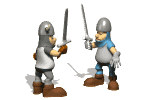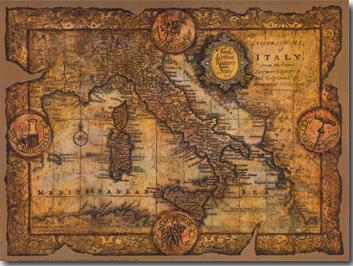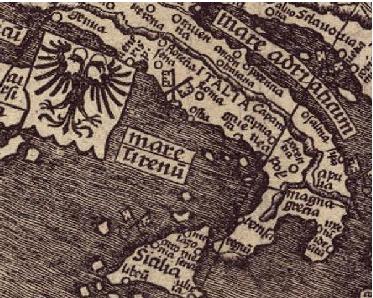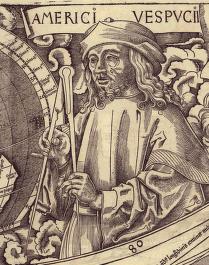
Candida Martinelli's Italophile Site

Main
Page This family-friendly site celebrates Italian culture for the enjoyment of children and
adults. Site-Overview
These
are links to my pages on Italy's various historical eras.
See my
free Renaissance Figures you can print out to color, frame or to make
into paper dolls.
Cover of the free e-book about the Renaissance in
Italy. This is a classic
work on the Italian Renaissance: 'The Civilization of the
Renaissance in Italy' by Jacob Burckhardt from 1878, translated
by S.G.C. Middlemore. I had to edit the text due to the poor
quality of the public domain edition. The book is 349
pages long, followed by two pieces I added about the author and his
writings on history. Sample page from the free e-book about the
Renaissance. I've added
appropriate graphics at the start of each chapter. The chapter
headings are: The State as a Work of Art, The Development of the
Individual, The Revival of Antiquity, The Discovery of the World and of
Man, Society and Festivals, Morality and Religion. The Costumer's Manifesto site at Costumes.org
offers everything you could ever want to know about how Italians
dressed, danced and wore their hair during the Renaissance. They
even have patterns. This is part of a map from the
late Renaissance showing Italy. The logo above links to 'The
History Guide' article on The Age of Discovery. It is excellent,
and from there you can link to other wonderful articles. There is
quite a bit about Columbus in the linked article. This is an image of Explorer
Amerigo Vespucci from a very famous map made by Martin Waldseemüller
who lived from 1470 to 1521. He is the man who pushed to have the
New World named for Vespucci. No, not to call it Vespucci, but to
call it America. Click on the logo of the
'Catholic Encyclopedia' site above, to read their article on The
Reformation. It's very interesting to read the Catholic
perspective on a religious revolution that divided the Christian church
in two. And click here
to read about a Vatican exhibit that details how the Popes rebuilt Rome
during the Renaissance. Click on the logo for the
'Internet Medieval Sourcebook' site to find online versions of original
documents from the Medieval period, mainly pertaining to The Reformation
and Counter-Reformation. This is an image of north and
central Italy during the Renaissance. Click on the image to go to
'The Medieval Sourcebook' site's list of maps, where you will find this
one and others of Italy through time.
There is a
wonderful book about the customs of the Middle Ages and the
Renaissance that includes many images, and tons of curious
information.
It is available to read on-line via Gutenberg Press, for free. The
visible remains of Il Rinascimento are the architecture and art,
but it is the ideas of time that really caused the re-birth of society
and the human spirit from roughly the 1300s to the 1600s in
Italy. Medieval
society was swept aside by ideas such as humanism, individuality,
a secular society, realism, education, self-improvement, good
governance, intellectual curiosity. It
is these ideas that made their way north and seeded the Northern version
of the Renaissance that was more focused on ideas rather than art, leading
to the Enlightenment and modern society. It
was the growth of commerce and foreign influences in the port and
trade cities that stimulated this embracing of new ideas.
Italy was not as feudal as the rest of Europe.
Her city-states and well-developed ports provided independence
from the invasive Catholic church and the repressive feudal lords. And
commerce required skilled laborers in many different fields, building a
middle class that was eager to have their children escape the drudgery
and precariousness of agricultural life.
Education was recognized for the first time as the key to advancement
and a better life. The
intellectually curious during the Renaissance looked to the Ancient
Greeks as an example of a society that searched for answers to life’s
questions in reason, logic, ethics and science.
Ancient Roman writers, who learned from the Greeks and either
revived or expanded on their ideas were also embraced. Greco-Roman
classicism became the intellectual starting point, and all the old texts
they could find were translated and studied.
Schools were founded to teach the social sciences, arts,
and sciences. Intellectual
curiosity was encouraged. Experimentation
and human achievement was rewarded. The study and description of
mankind and civilization's systems is exemplified by Machiavelli,
who was an early political scientist and historian. The
names of the greats of the Italian Rinascimento are well-known
throughout the world. In literature, Dante is often considered the first
Renaissance writer, writing the famous allegory about man’s journey
through life, The Divine Comedy, in Italian. No
longer was literature only for monks, but it was now for the educated
common, secular man. Petrarch,
Boccaccio, Castiglione, Ariosto and many others followed Dante,
writing works that entertained and edified the educated Italians of
their day. The
Renaissance artists are too many to name them all, but the earliest is
usually considered Giotto, who broke from the medieval static
designs and symbolism to create more naturalistic images that anyone
could understand and appreciate. He
was followed by Botticelli, Rafaello, Donatello, Da
Vinci, and Michelangelo to name a few.
They were often versatile artists, achieving success several
artistic fields, rather than specializing like artists before them. Vasari
famously wrote mini-biographies of them during the Renaissance, ensuring
them lasting fame. They
excelled in sculpture, architecture, painting, decorating, ceramics,
metal casting, entertainments, mechanics, and decorating.
They helped create the description of a multi-talented person as
a Renaissance Man. Florence
was the center of the Italian Rinascimento.
The ruling merchant family, the Medici, encouraged and
gloried in Florentine invention and art.
Every advancement and accomplishment was seen as enhancing the
Medici standing in the known world.
The
wealth pouring into the region was used to fund ever greater showpieces
for the Medici and the many merchant families.
This personal aggrandizement, rather than piety and payments to
the church, eventually was repeated in the merchant countries of
northern Europe. A
great Italian figure during this time was Marco Polo, famous for
his accounts of his travels in the east: 'The Milione - TheTravels of
Marco Polo'. Wikipedia
has a great page if you want to know more. The
Renaissance lead directly to the great period of exploration of the
globe, from the 1480s onward, by explorers financed by monarchies
of trading nations and rich trading republics, like Genoa and Venice,
searching for new markets, resources and trade routes.
Most
of the stars at the beginning of the era were Spanish and Portuguese,
and later the English and French. But
some of the stars of the era were Italian, either as captains of
explorations, like Columbus, or as navigators, geographers and
map-makers, like Amerigo Vespucci. The
great expansion of trade, wealth and commerce during this period also
financed explorations in science and invention.
For example, in the field of map-making,
inventions like the compass and accurate timepieces and other devices to
assist accurate measurement and travel around the globe were developed,
often at the instigation of the governments which were becoming ever
richer by their growing foreign empires.
Maps and map-makers were powerful economic tools defended to the
death. Armies
traveled after the explorers, conquering lands, decimating local
populations, and keeping the riches out of the clutches of other trading
nations. Empires were
built, and consciences were soothed by the myth that the western
conquerors were bringing religion, civilization, modern medicine and
effective administrations to backward peoples.
All the while those peoples were dying and being exploited and
robbed. The Age of
Colonialism had arrived. During
this era, the Catholic church was challenged by the Reformation
that produced Protestantism in the 1500s.
The Catholic church fought back with the Counter-Reformation
which relied heavily on Inquisitors to scare people back to the faith.
The
religious wars that followed throughout Europe (France, German,
Spain, Britain, the Low Countries…) would cause many deaths, shape
whole countries and governments, and cause mass emigrations.
Many
monarchies had staked their legitimacy on allegiance to the Catholic
church, and the church relied on their territories for their income.
So these were bloody
fights that ended in divisions that remain to this day, most
visibly in Belgium which is one country in name only, in reality divided
between the Protestant Flemish and the Catholic Walloons. But
Italy remained predominantly Catholic, partly due to the strenuous and
bloody efforts of the Inquisition which was especially strong there, and
in Spain and France. And
the Catholic church retained land in central Italy, including Rome
and the Vatican. The
Papacy was offered military protection by the Catholic monarchies,
namely Spain and France. It
was only when French protection was withdrawn in 1870 that Rome joined
the rest of unified Italy, leaving the Vatican as an independent state
reliant on the good-will of the Italian government for its survival. Next Section: The Age of Colonialism,
Capitalism, Reason, and the Industrial Revolution

Italian
History
![]()



Manners, Customs, and Dress During the Middle Ages, and During the
Renaissance Period.
By Paul Lacroix
(Bibliophile Jacob),
Curator of the Imperial Library of the Arsenal, Paris.Illustrated with
Nineteen Chromolithographic Prints by F. Kellerhoven
and upwards of
Four Hundred Engravings on Wood
Il
Rinascimento - The Renaissance
The
Age of Discovery